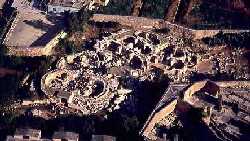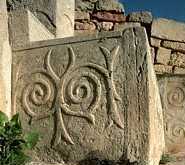

STONE AGE
BUILDING INDEX
STONE AGE
BUILDING
STANDING
STONES
NEWGRANGE
STONEHENGE
MALTA'S
MEGALITHIC
MARVELS
introduction
timeline
temple sites
ggantjia
hager qim
mnajdra
hypogeum
tarxien
magna mater
magna mater-myth
gallery
SKARA BRAE
HUNEBEDDEN
Tarxien

The Tarxien temple complex is a bit sad, to be honest. All the magic that it once must have had is gone. How come? As the picture clearly shows, Tarxien found itstel back in the middle of the town of Paola. Houses all around and although there is a wall around the complex, you can see the laundry hanging from the balconies of the villagers. I have to say, that was a bit disappointing at first.
Tarxien gave its name to the last temple period, which was from 3000 to 2500 BCE. It is situated only a few honderd meters from the Hal Saflieni (the Hypogeum). Scolars think this indicates there is a relation between the two of them.
The Tarxien temple complex turned out to be the richest deposit of prehistorical art objects on the Maltese islands, so far. It was left untouched for thousands of years until it was discovered again in WOI. Most of the artefacts are shown at the National Museum for Archeology in Valletta. On the site, the artefacts have been replaced by copies which give a good idea of how it once must have been.
There are four distinct temple units at Tarxien. The oldest one, smaller of size an separated from the others, was built in the Ggantija phase and has the typical five-asped plan, just like Ggantija temple itself. The other three are joined together by a common outer wall. The middle temple was the last one to be erected and was wedged between the other two, spoiling the symmetry of the complex itstelf.
Spirals
 Lots and lots of spirals and other decorations at Tarxien. These patterns are normally incised on the polished surface of a pot or stone, but every now and then they are formed by applied small discs of against a stippled background. Most appealing is still that these people had no tools of bronze or iron: all the carving were made with stonetools.
Lots and lots of spirals and other decorations at Tarxien. These patterns are normally incised on the polished surface of a pot or stone, but every now and then they are formed by applied small discs of against a stippled background. Most appealing is still that these people had no tools of bronze or iron: all the carving were made with stonetools.
The spiral designs from the prehistoric temples have become a symbol of Malta itself. Many look alike, but none is exactly the same as another. Michael Ridley wrote this about them: "The motifs are curvilinear, derived from or consisting of spirals and circles. Perhaps the most interesting are the curvilinear motifs, they are also the most prolific, the majority being at Tarxien, while others were found at Bugibba, Ggantija, Hagar Qim, Tas-Silg and the Hal-Saflieni Hypogeum. The basic component of these designs is the spiral. It appears in a number of forms as double opposed spirals arranged as oculi, as combinations of single spirals, sometimes described as 'C' spirals, as 'S' spirals, including reversed and horizontal versions and then other components are derived from the spiral."
NEWGRANGE STONEHENGE MALTA'S MEGALITHIC MARVELS SKARA BRAE
